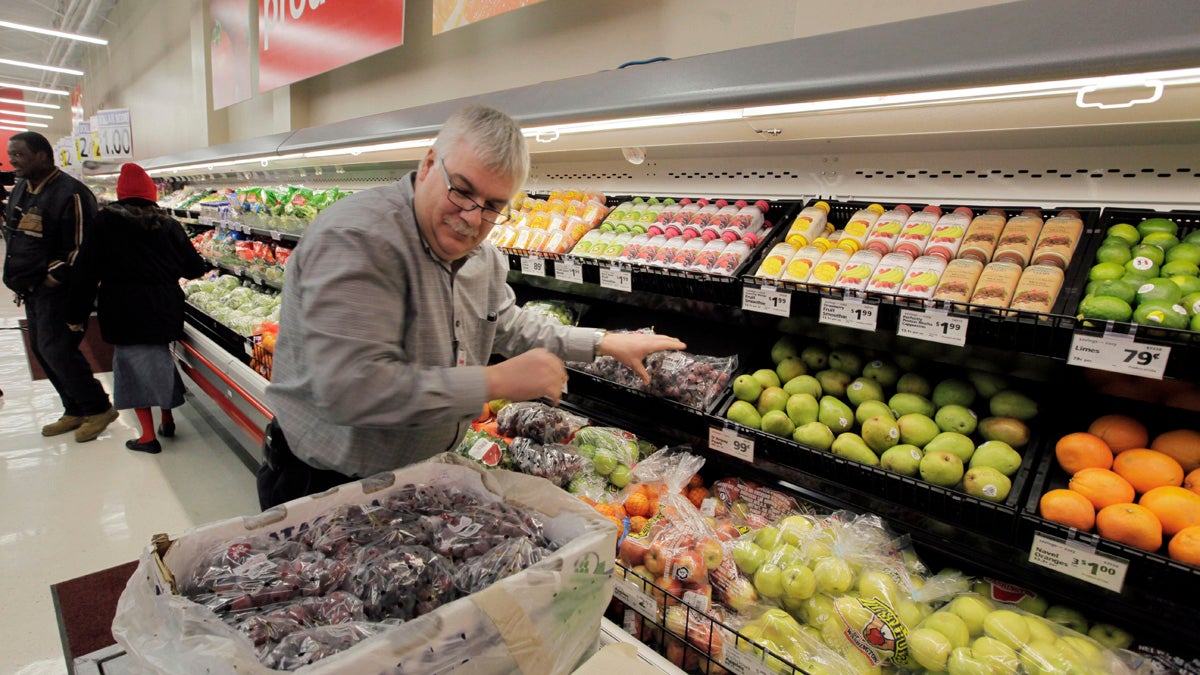A&P’s second bankruptcy just the latest in market shakeup
Listen
A Save-A-Lot Food Store employee is shown stocking produce at a store in Chicago's south side. The store was one of five that opened in the area in an effort to bring healthy food choices to families who have not had access to nutritious foods. A new study challenges that premise. (AP Photo/M. Spencer Green, file)
The latest supermarket shakeup is under way for Philadelphia-area shoppers. NewsWorks Tonight host Dave Heller turned for the details to Richard George, St. Joseph’s University professor and food industry analyst.
DAVE HELLER: A&P filed for bankruptcy this week. I think they have almost 300 stores and they say they’re going to close 25 of them. Are they specifically in our area?
RICHARD GEORGE: There are a number in the Philadelphia area — the ones that Acme or someone else does not pick up, they probably will close.
What are the implications for customers?
Well, I think for customers, first of all unfortunately, A&P under the old SuperFresh banner and Pathmark, they were just both very tired concepts. Matter of fact, when they announced that merger several years ago, I commented it looked like two giants wobbling toward insolvency. And unfortunately that came to pass.
I think shoppers are going to see better stores. Acme is on the rebound. I think Acme will clean them up, I think they’ll provide the kind of pricing and the assortment that A&P at one time was known for.
You know, a Wall Street Journal article back in the ’40s said by 1951, every corner market will have an A&P on it. So they were the kings at one time. They got a little complacent; they lost sight of the customer; they didn’t recognize the changing competition; and, now, this is their second — and probably final — bankruptcy.
Well, let’s talk about that changing competition. When A&P and Acme ruled the supermarket world, there was scarcely any such thing as Trader Joe’s, Whole Foods at one end and Walmart and even Rite Aids at the other.
That’s right, I mean there was a time even as recently as let’s say a dozen years ago, maybe beginning of this century, the ones you mentioned weren’t here, Aldi wasn’t here, dollar stores weren’t major players, and Wegman’s wasn’t in the market.
Giant was not as big a player. It was a very very different market when Acme ruled the world years ago, and A&P was right with them. If you were a Philadelphia person … you shopped either at Acme or A&P. Or as we say, ACK-a-me, or A&P.
To what extent does this mirror a national trend, or is Philadelphia particularly saturated with competition?
Philadelphia probably is “over-stored.” The difficulty we have, as you mentioned, you have the Walmarts, the dollar stores, the Aldis on one end, you have the Trader Joe’s and Wegman’s on the other end, and if you’re Acme today, you will be challenged because you’re in the middle.
What’s your point of difference? Is it better quality? Better service? Better prices? If it’s not any of those things, it’s hard to compete there. Giant does a good job. So I think Giant and Acme will occupy that so-called “big middle,” but I still think they’re going to continue to be nibbled at by the people on the fringe.
So if you were an Acme or an A&P years ago, pretty much you could do business every day by opening the doors. That’s no longer good enough. You have to look at the changing consumer, you have to look at how the competitive array is changing.
If we look at technology, we look at Amazon, you can purchase goods on Amazon online.
I just did some research and a national sample: 24 percent of millennials say that they’ve shopped the last 30 days for food online, and only 56 percent of the same group has visited a supermarket in the last 30 days. That’s heretical.
Think of national averages; about 90 to 95 percent of us get to a supermarket once a month. This next generation is not going to shop in supermarkets. So there will be a lot of challenges going forward.
Is that where we’re going in the future?
Oh, I think so. Without a doubt. Do we really need to walk into ShopRite to inspect our Cheerios or Heinz ketchup?
I see the day when … you’re going to order all that online, and you’re going to go to your local ShopRite, you’re going to go inside with an empty cart, you’re going to shop what we call the perimeter of the store now which will be a bigger part of the store.
You’re going to buy the fresh fish, the meats, you’re going to buy the flowers for your wife and the cheeses, and then you’re going to pull around back and you’re going to load the Cheerios and Heinz ketchup and everything else that you bought, the bulky items, which you didn’t need to shop for, put that into your car, and you’ll be on your way.
WHYY is your source for fact-based, in-depth journalism and information. As a nonprofit organization, we rely on financial support from readers like you. Please give today.


